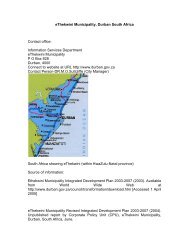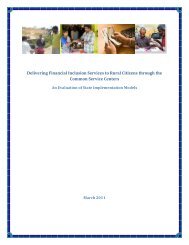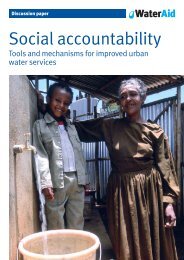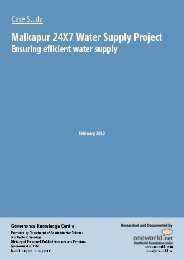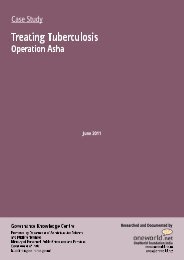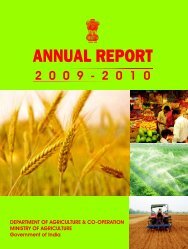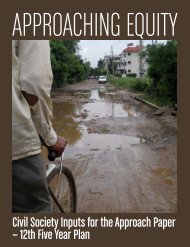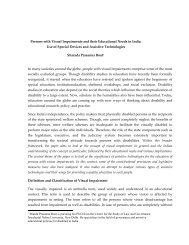See full case study - Indiagovernance.gov.in
See full case study - Indiagovernance.gov.in
See full case study - Indiagovernance.gov.in
- No tags were found...
Create successful ePaper yourself
Turn your PDF publications into a flip-book with our unique Google optimized e-Paper software.
Governance Knowledge CentrePromoted by Department of Adm<strong>in</strong>istrative Reforms and Public GrievancesM<strong>in</strong>istry of Personnel, Public Grievances and PensionsGovernment of IndiaCase StudyUrban DevelopmentIn-Situ Slum Upgradation under JNNURMTRANSPARENCY AND ACCOUNTABILITYJanuary 2012EXECUTIVE SUMMARYWhile the challenges of urbanisation are plenty, exponential growth of <strong>in</strong>formal settlements isone of the most alarm<strong>in</strong>g. People liv<strong>in</strong>g <strong>in</strong> these settlements lack basic necessities, and have<strong>in</strong>human standard of liv<strong>in</strong>g. Apart from the anguish of liv<strong>in</strong>g with the constant fear of be<strong>in</strong>guprooted, they cont<strong>in</strong>uously deal with issues of make shift houses, lack of toilet, electricity andwater supply challenges.The <strong>gov</strong>ernment of India has launched national and state level policies and schemes to addressvarious aspects of slum rehabilitation and resettlement. However, recent studies have <strong>in</strong>dicated<strong>in</strong>adequacy <strong>in</strong> these efforts while deal<strong>in</strong>g with the needs and aspirations of the slumcommunity. The conventional approach of build<strong>in</strong>g rehabilitation colonies <strong>in</strong> peri-urban 1localities is not prov<strong>in</strong>g beneficial for the community. Relegat<strong>in</strong>g the urban poor to theperipheries of the city not only takes away the right of the poor to live where they desire butalso <strong>in</strong>directly aggravates poverty by impos<strong>in</strong>g <strong>in</strong>creased transportation on and liv<strong>in</strong>g cost onthese unskilled labour force. The provisions of demolish<strong>in</strong>g the exist<strong>in</strong>g slums for eithersanitis<strong>in</strong>g the cities or for rebuild<strong>in</strong>g new hous<strong>in</strong>g facilities also fail to consider the emotionalbond<strong>in</strong>g people hold with their localities.The Pune Municipal Corporation came up with a unique community driven <strong>in</strong>-situ slumupgradation project under Basic Services to the Urban Poor (BSUP) scheme of JawaharlalNehru National Urban Renewal Mission (JNNURM). This project recognises the prevail<strong>in</strong>gconcerns of the urban poor and thereby <strong>in</strong>tegrates the community <strong>in</strong> its plann<strong>in</strong>g andimplementation process. The uniqueness of the project lies <strong>in</strong> its <strong>in</strong>-situ design that allows thelocals to have houses with all the basic amenities <strong>in</strong> their own settlements without bear<strong>in</strong>g thebrunt of be<strong>in</strong>g uprooted to a <strong>gov</strong>ernment imposed outskirt 2 . Every household was designed <strong>in</strong>consultation with the future residents of the houses. . The project gave special emphasis on thesanitation, hygiene, ventilation and light<strong>in</strong>g requirement of the community. The highlight ofthe project is its provision of secure tenure for the slum dwellers, otherwise liv<strong>in</strong>g with theconstant <strong>in</strong>security of be<strong>in</strong>g uprooted by the <strong>gov</strong>ernment.1Peri-urban areas are adjo<strong>in</strong>ed to an urban area and located between the suburbs and the countryside.2In-situ slum re-development model refers to the process of redevelopment of slum areas by provid<strong>in</strong>g dwell<strong>in</strong>gspace and other basic civic and <strong>in</strong>frastructural services to the slum dwellers, on the exist<strong>in</strong>g land on which the slumis based. Source: Government of India. M<strong>in</strong>istry of Hous<strong>in</strong>g and Urban Poverty Alleviation. Model Property Rightsto Slum Dwellers Act 2011. Web 1 February 2012..1Researched and documented byOneWorld Foundation India
Governance Knowledge CentrePromoted by Department of Adm<strong>in</strong>istrative Reforms and Public GrievancesM<strong>in</strong>istry of Personnel, Public Grievances and PensionsGovernment of IndiaCase StudyUrban DevelopmentIn-Situ Slum Upgradation under JNNURMTRANSPARENCY AND ACCOUNTABILITYJanuary 2012This project has emerged as an <strong>in</strong>novative solution to slum rehabilitation challenges <strong>in</strong> thedevelop<strong>in</strong>g world. Its <strong>in</strong>-situ model and community driven approach has made it a prototypeof good <strong>gov</strong>ernance <strong>in</strong> urban hous<strong>in</strong>g and poverty alleviation. Recently this project wasselected by Smithsonian Cooper-Hewitt, National al Design Museum, New York to display itsmodel at an exhibition titled Design with Other 90 % Cities, which explores design solutionsaddress<strong>in</strong>g challenges created by rapid acceleration <strong>in</strong> urban <strong>in</strong>formal settlements.METHODOLOGYThe Governance Knowledge Centre decided to document the Pune slum upgradation project asa best practice because it <strong>in</strong>corporates <strong>in</strong>novative approach to follow <strong>in</strong>-situ rehabilitationstrategy under the JNNURM project. The rationale of this <strong>in</strong>-situ approach is to acknowledgethe economic implication and emotional bond<strong>in</strong>g the slums communities associate with theirown settlements. Unlike other conventional Rehabilitation and Resettlement and slumupgradation policies and programmes, this unique project neither adopts the blanket measureof demolish<strong>in</strong>g the entire slum areas and rebuild<strong>in</strong>g it from the scratch nor does it take theslum community out of the city to sanitise the urban space. Instead this project isconceptualised by the local <strong>gov</strong>ernment authorities to be implemented by NGOs work<strong>in</strong>g forhous<strong>in</strong>g and sanitation concerns of the urban poor <strong>in</strong> close association with the localcommunity.The Governance Knowledge Centre team used both primary and secondary research methodsfor the preparation of this best practice document.Secondary research was conducted to understand the policy implications of JNNURM for slumresettlement <strong>in</strong> the city of Pune and the currents debates surround<strong>in</strong>g policies and challengesrelated to hous<strong>in</strong>g, sanitation and basic services provisions <strong>in</strong> slum areas. Important<strong>in</strong>formation on the Pune <strong>in</strong>-situ slum upgradation project was gathered from ma<strong>in</strong>lynewspaper articles and reports published by the Society for the Promotion of Area ResourceCentres (SPARC) and Prasanna Desai Architects. In order to validate the secondary researchf<strong>in</strong>d<strong>in</strong>gs and to gather specific <strong>in</strong>sights, a telephonic <strong>in</strong>terview was conducted with architectMr. Prasanna Desai, who designed the houses.There are multiple stakeholders <strong>in</strong>volved <strong>in</strong> various aspects of the project implementation.However, the researcher could not <strong>in</strong>teract with all the stakeholders <strong>in</strong>volved, <strong>in</strong>clud<strong>in</strong>g thebeneficiaries, while prepar<strong>in</strong>g this documentation. This can be considered as a limitation <strong>in</strong>depict<strong>in</strong>g a comprehensive illustration of the project implementation process.1Researched and documented byOneWorld Foundation India
Governance Knowledge CentrePromoted by Department of Adm<strong>in</strong>istrative Reforms and Public GrievancesM<strong>in</strong>istry of Personnel, Public Grievances and PensionsGovernment of IndiaCase StudyUrban DevelopmentIn-Situ Slum Upgradation under JNNURMTRANSPARENCY AND ACCOUNTABILITYJanuary 2012BACKGROUNDAs the population of the country is rapidly start<strong>in</strong>g to concentrate <strong>in</strong> the urban geography,severe constra<strong>in</strong>ts are encountered by cities <strong>in</strong> extend<strong>in</strong>g basic facilities for a decent standard ofliv<strong>in</strong>g, especially to the urban poor. With the alarm<strong>in</strong>g <strong>in</strong>crease <strong>in</strong> rural to urban migration,ma<strong>in</strong>ly propelled by stagnation and volatility of agricultural sector and lack of othersusta<strong>in</strong>able livelihood generation activities <strong>in</strong> rural areas, the city spaces are becom<strong>in</strong>gclaustrophobic. The migrants, particularly the unskilled labour force, who enter the city <strong>in</strong>search of better employment opportunities, mostly end up settl<strong>in</strong>g <strong>in</strong> the slum settlements,which is def<strong>in</strong>ed by the United Nations Habitat as a heavily populated urban area characterisedby substandard hous<strong>in</strong>g and squalor. 3 Although hous<strong>in</strong>g is a major issue <strong>in</strong> all the Indian citiesit is most unprecedented for the 75.26 million people liv<strong>in</strong>g <strong>in</strong> slums. 4As per the Census of India 2001, the population of Pune is approximately 25 lakhs, out ofwhich, an estimated 30-35 35 per cent are the urban poor resid<strong>in</strong>g <strong>in</strong> 564 slums of the city. 5 Thegrowth of slum population is higher than that of the total population and the density <strong>in</strong> slumsis about 6 times compared to the overall density of population <strong>in</strong> the city. Specifically, <strong>in</strong> theWarje Karvenagar area of Pune the slum density is 23, 509 persons per hectare <strong>in</strong> comparison to97 persons <strong>in</strong> the non slum areas. Accord<strong>in</strong>g to the estimates of the Pune MunicipalCorporation, 27 percent of the city’s population resides <strong>in</strong> 353 notified slums cover<strong>in</strong>g only 4percent of the city area. 6 As per the Shelter Survey conducted by PMC <strong>in</strong> 2000, 52 percent of thehous<strong>in</strong>g is <strong>in</strong> the kuccha category, most of households do not have proper access to basicservices or have to share community facilities. These statistics clearly portrays the saturat<strong>in</strong>gconditions of land and resources, <strong>in</strong>adequate access to safe water, hygiene and sanitation<strong>in</strong>frastructure along with the persist fear of liv<strong>in</strong>g everyday with the quasi-legal or illegalresidential tenure-status.3 Gruber, Denis, et all. Liv<strong>in</strong>g and work<strong>in</strong>g <strong>in</strong> slums of Mumbai. 2005. Web 14 January 2012. < http://www.uni-magdeburg.de/isoz/publikationen/download/36.pdf/>.4 Government of India. M<strong>in</strong>istry of Hous<strong>in</strong>g and Urban Poverty Alleviation. Press Information Bureau Notificationof Slums 24 May 2011. .5 Pune Municipal Corporation. Jawaharlal Nehru National Urban Renewable Mission (JNNURM): City DevelopmentPlan 2006-12. Declared slum 353, undeclared 1506Notified slums are those that have been notified as slums by municipalities, corporations, or any other localauthority. Out of 564 slums <strong>in</strong> the Pune city 353 are notified and 211 are undeclared.1Researched and documented byOneWorld Foundation India
Governance Knowledge CentrePromoted by Department of Adm<strong>in</strong>istrative Reforms and Public GrievancesM<strong>in</strong>istry of Personnel, Public Grievances and PensionsGovernment of IndiaCase StudyUrban DevelopmentIn-Situ Slum Upgradation under JNNURMTRANSPARENCY AND ACCOUNTABILITYJanuary 2012The <strong>gov</strong>ernment of India under the M<strong>in</strong>istry of Urban Development launched the JawaharlalNehru National Urban Renewal Mission (JNNURM) <strong>in</strong> the year 2005 with the aim of creat<strong>in</strong>geconomically productive, efficient, equitable and responsive cities by a strategy of upgrad<strong>in</strong>gthe social and economic <strong>in</strong>frastructure <strong>in</strong> cities. The provisions of Scheme of Hous<strong>in</strong>g andShelter Up- gradation (SHASU) 1990, Basic Services to the Urban Poor (BSUP) 2005-06,Integrated Hous<strong>in</strong>g and Slum Development Programme (IHSDP) 2005, National UrbanHous<strong>in</strong>g and Habitat Policy 2007 and Rajiv Awas Yojana 2009 are launched subsequently <strong>in</strong>accordance with the 74th Constitutional Amendment Act, 1992. The <strong>gov</strong>ernment of Pune hasalso been implement<strong>in</strong>g a range of schemes for slum improvement over the years. GovernmentRedevelopment Scheme was <strong>in</strong>troduced to enable free construction of houses of about 270 sqfeet built up area. This scheme was implemented <strong>in</strong> 78 slums <strong>in</strong> city. Under the Paid ToiletScheme Pune Municipal Corporation (PMC) provided 773 sanitation blocks <strong>in</strong> the slum areas.In order to recognise the slum dwellers identity to help them avail slum improvement benefits,PMC started the Photo Pass Scheme which could cover around 10,000 slum dwellers. Anotherscheme implemented by the PMC with assistance from the <strong>gov</strong>ernment of India is the Valmiki-Ambedkar Awas Yojana where<strong>in</strong> slum dwellers liv<strong>in</strong>g below the poverty l<strong>in</strong>e are given asubsidy of INR 50,000 for construct<strong>in</strong>g a house of 225 sq feet.Thus, <strong>in</strong> urban India local municipalities have the authority and responsibility of provid<strong>in</strong>ghous<strong>in</strong>g and city level <strong>in</strong>frastructure accord<strong>in</strong>g to the rationale of democratic decentralisation.But <strong>in</strong> practice, f<strong>in</strong>ancial support, hous<strong>in</strong>g development and provision of basic services havehuge discrepancies <strong>in</strong> almost all the <strong>gov</strong>ernment promoted low-<strong>in</strong>come settlements, translat<strong>in</strong>g<strong>in</strong>to a visible gap between the vision and successful implementation.The recent debate over the susta<strong>in</strong>ability of resettlement colonies constructed <strong>in</strong> peri-urbanlocalities has brought to light many realities perta<strong>in</strong><strong>in</strong>g to <strong>in</strong>convenience and <strong>in</strong>securities facedby the urban poor <strong>in</strong> those <strong>gov</strong>ernment imposed settlements. Those resettlement colonies builtunder the <strong>gov</strong>ernment’s flagship policies deny the right of the poor to reside <strong>in</strong> a city. The poorare relocated outside the peripheries of the urban space from where they need to commutedaily to the city for avail<strong>in</strong>g livelihood opportunities. As the commutation expenses grow, theimportance and utility of hous<strong>in</strong>g facilities dim<strong>in</strong>ishes, lead<strong>in</strong>g to beneficiaries sell<strong>in</strong>g of thesehouses and return<strong>in</strong>g to some other slum <strong>in</strong>side the city -and the cycle cont<strong>in</strong>ues.The provisions of demolish<strong>in</strong>g the exist<strong>in</strong>g slums for either sanitis<strong>in</strong>g the cities or for rebuild<strong>in</strong>gnew hous<strong>in</strong>g facilities do not to consider the emotional bond<strong>in</strong>g the people hold with theirdwell<strong>in</strong>gs and localities. The policy makers often fail to comprehend the emotional valueattached with the exist<strong>in</strong>g houses that had been built by the poor with their hard earnedmoney. The provisions of provid<strong>in</strong>g one-time grant or a small piece of land to the slum1Researched and documented byOneWorld Foundation India
Governance Knowledge CentrePromoted by Department of Adm<strong>in</strong>istrative Reforms and Public GrievancesM<strong>in</strong>istry of Personnel, Public Grievances and PensionsGovernment of IndiaCase StudyUrban DevelopmentIn-Situ Slum Upgradation under JNNURMTRANSPARENCY AND ACCOUNTABILITYJanuary 2012dwellers for construct<strong>in</strong>g houses on their own, with no access to affordable loans, andtechnological and architectural expertise for construction, also fall short of provid<strong>in</strong>gsusta<strong>in</strong>able solution to the homeless.On recognis<strong>in</strong>g the importance of address<strong>in</strong>g there press<strong>in</strong>g concerns to build an <strong>in</strong>clusiveurban space and to fill <strong>in</strong> the gaps <strong>in</strong> the exist<strong>in</strong>g slum development policies, a uniquecommunity driven <strong>in</strong>-situ project was designed by the PMC under BSUP scheme of JNNURM.This project, designed to upgrade 7 high density slum areas <strong>in</strong> Yedwara region of Pune, isemerg<strong>in</strong>g as a dist<strong>in</strong>guished effort that is receiv<strong>in</strong>g national and <strong>in</strong>ternational accolades.Innovativeness of this project lies <strong>in</strong> its hous<strong>in</strong>g designs that allow the locals to have houseswith all the basic amenities <strong>in</strong> their own settlements without bear<strong>in</strong>g the brunt of be<strong>in</strong>guprooted to a <strong>gov</strong>ernment imposed outskirt.OBJECTIVEThe objective of the project was to improve liv<strong>in</strong>g conditions <strong>in</strong> the slum areas of Pune. It aimedto build houses with all the basic amenities like sanitation and better ventilation. As lack oftoilets was a major issue <strong>in</strong> these high density slums pockets, special emphasis was given onbuild<strong>in</strong>g <strong>in</strong>-door sanitation facility. The project targeted to develop a total of 4,000 units <strong>in</strong> Puneout of which 1,099 kuccha houses were selected under Yerwada region.PROGRAMME/PROJECT ROJECT DESIGNKEY STAKEHOLDERS1. Pune Municipal Corporation (PMC) undertook the <strong>in</strong>-situ slum upgradation projectunder the central <strong>gov</strong>ernment’s scheme of Basic Services for the Urban Poor (BSUP)under the Jawaharlal Nehru National Urban Renewal Mission (JNNURM). PMCselected 7 slums <strong>in</strong> the Yerwada region of Pune for upgradation. PMC came up with atender for the NGOs to apply for tak<strong>in</strong>g up the project. The NGO had to have strongcommunity presence and experience of work<strong>in</strong>g closely with the local electedrepresentatives.2. The Society for the Promotion of Area Resource Centres (SPARC) was appo<strong>in</strong>ted bythe PMC to implement the project. SPARC is a national-level level NGO that works on theissues of hous<strong>in</strong>g and sanitation for the urban poor. SPARC <strong>in</strong>itiates efforts to organiseand mobilise communities of the slum dwellers to help them ga<strong>in</strong> access to resourcesrequired for upgradation and formalisation of the various forms of <strong>in</strong>formal1Researched and documented byOneWorld Foundation India
Governance Knowledge CentrePromoted by Department of Adm<strong>in</strong>istrative Reforms and Public GrievancesM<strong>in</strong>istry of Personnel, Public Grievances and PensionsGovernment of IndiaCase StudyUrban DevelopmentIn-Situ Slum Upgradation under JNNURMTRANSPARENCY AND ACCOUNTABILITYJanuary 2012settlements. SPARC has been work<strong>in</strong>g together with Mahila Milan and National SlumDwellers Federation (NSDF) on these issues and their partnership is called an Alliance.This alliance <strong>in</strong> partnership with CHF –International undertook the responsibility ofconduct<strong>in</strong>g biometric and socioeconomic survey of the slums, appo<strong>in</strong>t<strong>in</strong>g architects,monitor<strong>in</strong>g construction process, and devis<strong>in</strong>g f<strong>in</strong>ancial strategies and ensur<strong>in</strong>geffective community participation and equitable distribution of resources.a. NSDF is a community based organisation comprised of community membersand leaders resid<strong>in</strong>g <strong>in</strong> the <strong>in</strong>formal settlements across India. NSDF helps theurban poor <strong>in</strong> build<strong>in</strong>g an organised strength aga<strong>in</strong>st demolition and forsecur<strong>in</strong>g basic amenities of water and sanitation <strong>in</strong> the <strong>in</strong>formal settlements.b. Mahila Milan is a decentralised network of collectives of poor womenpropagat<strong>in</strong>g credit and sav<strong>in</strong>g programmes <strong>in</strong> their communities.3. CHF-International is an organisation funded by the Bill & Mel<strong>in</strong>da Gates Foundationwith the objective of facilitat<strong>in</strong>g community <strong>in</strong>volvement <strong>in</strong> the plann<strong>in</strong>g andimplementation of slum improvement programmes. It provides f<strong>in</strong>ancial support toSPARC <strong>in</strong> various stages. Most of the workshops undertaken by Mahila Milan to<strong>in</strong>volve community <strong>in</strong> the project implementation were funded by the CHF-International.4. Prassana Desai Architects , a renowned architect <strong>in</strong> Pune, was appo<strong>in</strong>ted by SPARC fordesign<strong>in</strong>g the houses <strong>in</strong> February 2009. Mr. Desai and his associates were responsiblefor verify<strong>in</strong>g and f<strong>in</strong>alis<strong>in</strong>g kuccha and pucca structures on site. The feasible build<strong>in</strong>gtypes were then designed keep<strong>in</strong>g the exist<strong>in</strong>g fabric of the slums <strong>in</strong> m<strong>in</strong>d. The teamhad the responsibility of expla<strong>in</strong><strong>in</strong>g the structure to the beneficiaries and <strong>in</strong>corporat<strong>in</strong>gtheir suggestions.1Researched and documented byOneWorld Foundation India
Governance Knowledge CentrePromoted by Department of Adm<strong>in</strong>istrative Reforms and Public GrievancesM<strong>in</strong>istry of Personnel, Public Grievances and PensionsGovernment of IndiaCase StudyUrban DevelopmentIn-Situ Slum Upgradation under JNNURMTRANSPARENCY AND ACCOUNTABILITYJanuary 2012PROCESS FLOWFRAMEWORK OF IN-SITU SLUM UPLIFTMENT PROJECT UNDER JNNURM IN PUNE:The PMC created theCity Development Planfor access<strong>in</strong>g the mission funds under theBasic Services for Urban Poor (BSUP) schemeof the JNNURM to improve urban<strong>in</strong>frastructure and services <strong>in</strong> the city.Subsequently, PMC received the funds underthe BSUP for undertak<strong>in</strong>g upgradation of 4000hous<strong>in</strong>g units to be implemented <strong>in</strong> packagesFigure 1: Pune slum upliftment project layout. Source:Prasanna Desai.of separate slum clusters. A hous<strong>in</strong>g subsidyof INR 3 lakhs was granted for develop<strong>in</strong>g theentire area of 270 sq feet per house to achieve a susta<strong>in</strong>able <strong>in</strong>clusive city.The project was launched <strong>in</strong> 2009 with the target of provid<strong>in</strong>g dwell<strong>in</strong>gs to the families of 1,099kuccha households resid<strong>in</strong>g <strong>in</strong> seven high-density slum areas <strong>in</strong> Yerwada. These <strong>in</strong>clude MotherTeresa Nagar, Sheela Salvenagar, Wadarwasti, Bhattnagar, Netaj<strong>in</strong>agar, Yashwantnagar andChandramanagar. The project is to be completed by March 2012.As per the guidel<strong>in</strong>es of JNNURM, the slums covered under the project are necessarily thenotified slums located on <strong>gov</strong>ernment land which is neither reserved for any public purposesnor an ecologically valuable space. Under this <strong>in</strong>-situ slum upgradation project there is theprovision of de-notify<strong>in</strong>g the site as a slum after the successful implementation of the project.After which the residents will be liable to pay the property taxes. While the benefit of theproject was restricted to those resid<strong>in</strong>g <strong>in</strong> kuccha houses, the households that were already puccacould not avail the hous<strong>in</strong>g subsidy, but given a grant of INR 15,000 for construct<strong>in</strong>g toilets. Asthe whole project is based on the cluster wise policy, eligible kuccha households are grouped<strong>in</strong>to clusters chosen by a natural order<strong>in</strong>g of hous<strong>in</strong>g arrangements that shared common wallsand boundaries.STAGES OF PROJECT IMPLEMENTATIONConduct<strong>in</strong>g surveys: Prior to project implementation, a range of surveys such as plane tablesurvey, biometric survey and socio-economic survey were conducted. This process was led bythe community itself <strong>in</strong> a drive to create a strong and mean<strong>in</strong>gful knowledge base for analys<strong>in</strong>g1Researched and documented byOneWorld Foundation India
Governance Knowledge CentrePromoted by Department of Adm<strong>in</strong>istrative Reforms and Public GrievancesM<strong>in</strong>istry of Personnel, Public Grievances and PensionsGovernment of IndiaCase StudyUrban DevelopmentIn-Situ Slum Upgradation under JNNURMTRANSPARENCY AND ACCOUNTABILITYJanuary 2012the context and current scenario, and thereby help <strong>in</strong> strategis<strong>in</strong>g for negotiation with the<strong>gov</strong>ernment and its <strong>in</strong>termediaries. The knowledge base conta<strong>in</strong>ed valuable <strong>in</strong>dicators ofnumber of households, residential and commercial land usage patterns, household level<strong>in</strong>come, employment type, education level, and detailed accounts of other basic facilitiesavailable <strong>in</strong> the locality. The <strong>in</strong>formation obta<strong>in</strong>ed helped <strong>in</strong> list<strong>in</strong>g the beneficiaries and <strong>in</strong>identify<strong>in</strong>g kuccha and pucca structures for project estimates. s. The socio economic surveyunraveled the mosaic of the society that had later on helped <strong>in</strong> understand<strong>in</strong>g the aspirationsand requirements of the community.Design<strong>in</strong>g suitable hous<strong>in</strong>g: The project focuses on upgrad<strong>in</strong>g exist<strong>in</strong>g houses <strong>in</strong>-situ that ison the exist<strong>in</strong>g foot pr<strong>in</strong>t, rather than on demolish<strong>in</strong>g the entire slum area for rebuild<strong>in</strong>g.Unlike <strong>in</strong> other conventional slum improvement schemes, this project allows the community toexercise <strong>in</strong>formed choice <strong>in</strong> f<strong>in</strong>alis<strong>in</strong>g a tailor-made design for their houses. Special emphasiswas given on <strong>in</strong>tegrat<strong>in</strong>g energy efficiency, flexibility of topology and quality of space <strong>in</strong> itsdesign.Community meet<strong>in</strong>gs to expla<strong>in</strong> the project design: Cluster meet<strong>in</strong>gs and workshops wereorganised by Mahila Milan and the architectural al team to expla<strong>in</strong> the possible hous<strong>in</strong>g layoutsto the residents. The meet<strong>in</strong>gs started with <strong>in</strong>troduc<strong>in</strong>g the community to the <strong>gov</strong>ernmentscheme and the NGOs who are implement<strong>in</strong>g it. Members of the clusters were categoricallyexpla<strong>in</strong>ed the f<strong>in</strong>ancial model of the project that requires 10 percent contribution from thebeneficiaries. Then the work<strong>in</strong>g design and the pace of the project were expla<strong>in</strong>ed by adopt<strong>in</strong>gvarious visual tools such as maps and cardboard blocks. Temporary model was built on the sitewith bamboo boo and cloth to allow clearer spatialunderstand<strong>in</strong>g of the design. This exercise notonly facilitated better understand<strong>in</strong>g of the modelbut also opened up space for new ideas andopportunities for mak<strong>in</strong>g the arrangements morebeneficiaries friendly.Figure 2: Community meet<strong>in</strong>gs organised byMahila Milan. Source: SPARCRanges of hous<strong>in</strong>g options: The architecture teamfocused on reta<strong>in</strong><strong>in</strong>g the footpr<strong>in</strong>t of each<strong>in</strong>dividual household, along with its streetpatterns, with an approximate carpet area of 135 sqfeet. The priority of the residents to stay on ground was taken care of <strong>in</strong> design<strong>in</strong>g the houses.Although the community has no secure tenure they often cl<strong>in</strong>g on to their land hold<strong>in</strong>g lead<strong>in</strong>gto the choice of houses on the ground floor. The concept of ow<strong>in</strong>g a floor on someone else’sland was not perceived to be a safe and comfortable option for the majority of residents.1Researched and documented byOneWorld Foundation India
Governance Knowledge CentrePromoted by Department of Adm<strong>in</strong>istrative Reforms and Public GrievancesM<strong>in</strong>istry of Personnel, Public Grievances and PensionsGovernment of IndiaCase StudyUrban DevelopmentIn-Situ Slum Upgradation under JNNURMTRANSPARENCY AND ACCOUNTABILITYJanuary 2012Consider<strong>in</strong>g the exist<strong>in</strong>g policy guidel<strong>in</strong>es and the difficulty of different footpr<strong>in</strong>ts presentwith<strong>in</strong> the different clusters the team came up with two hous<strong>in</strong>g choices - option A and optionB. Option A is an <strong>in</strong>dividual house, built as a Ground+1 structure and option B is an apartmentstyle Ground+2 build<strong>in</strong>g for irregular hous<strong>in</strong>g arrangements and small structures clusters. Thecommunity was given enough time and guidel<strong>in</strong>es to opt for any of these designs. Althoughmost of the residents opted for option A, smaller houses could not be accommodated <strong>in</strong> thiscategory. A lot of effort was required by the architecture team and Mahila Milan to conv<strong>in</strong>cepeople to opt for option B as it does not comply with their aspiration of hold<strong>in</strong>g on a land area.Figure 4: Hous<strong>in</strong>g model of option A. Source:SPARCFigure 3: Hous<strong>in</strong>g model of option B. Source:SPARCOn many accounts the work on entire 5-6 clusters had to be put on hold as few <strong>in</strong>dividualhouseholds were apprehensive <strong>in</strong> build<strong>in</strong>g a consensus for option B.Provision of basic services: The detailed community meet<strong>in</strong>gs had brought up the need forattached toilets, balconies and underground water storage tanks. Inclusion of a water storagetank led to the creation of a ‘veranda, a semi private <strong>in</strong>teractive space’ <strong>in</strong> front of everyhousehold. In order to reta<strong>in</strong> the scope for controlled <strong>in</strong>cremental growth over the years thearchitects molded the designs with addition of terraces. Special emphasis was also given to<strong>in</strong>corporate light<strong>in</strong>g and ventilation conditions.The f<strong>in</strong>al process of construction: After receiv<strong>in</strong>g consensus from the clusters through anextensive participatory process of consultation and modification, and verification of bankaccounts and other eligibility documents by the <strong>gov</strong>ernment authorities, the actual process ofconstruction began. Onset of the process made the stakeholders realise that the designsf<strong>in</strong>alised on many <strong>in</strong>stances subject to change as per the site condition. This resulted <strong>in</strong>consolidation of further community meet<strong>in</strong>gs for f<strong>in</strong>al approval. The project is currently <strong>in</strong> itsf<strong>in</strong>al stage of completion.1Researched and documented byOneWorld Foundation India
Governance Knowledge CentrePromoted by Department of Adm<strong>in</strong>istrative Reforms and Public GrievancesM<strong>in</strong>istry of Personnel, Public Grievances and PensionsGovernment of IndiaCase StudyUrban DevelopmentIn-Situ Slum Upgradation under JNNURMTRANSPARENCY AND ACCOUNTABILITYJanuary 2012FUNDINGThe central <strong>gov</strong>ernment releases 50 per cent of the funds for the project, 20 per cent comes fromthe state <strong>gov</strong>ernment and another 20 per cent from the municipalities. The community has tocontribute 10 per cent of the cost for the project, as per the guidel<strong>in</strong>es under the JNNURM.ACHIEVEMENTSInnovative <strong>in</strong>-situ model for slum upgradation: Unlike <strong>in</strong> other conventional slumrehabilitation projects, this <strong>in</strong>novative <strong>in</strong>-situ slum upgradation project of PMC consider thef<strong>in</strong>ancial, social and emotional security and comfort of those people resid<strong>in</strong>g <strong>in</strong> the slumpockets of the city. This model is based on the bottom-up development paradigm that seekseffective community <strong>in</strong>volvement <strong>in</strong> welfare projects to make it truly pro-poor and peoplecentric. The <strong>in</strong>novative exercise of facilitation better hous<strong>in</strong>g facilities <strong>in</strong> their exist<strong>in</strong>g footpr<strong>in</strong>ts, without relocat<strong>in</strong>g them to the peri-urban localities or by dismantl<strong>in</strong>g their exist<strong>in</strong>gsocial fabrics, has massively helped the urban poor <strong>in</strong> ma<strong>in</strong>ta<strong>in</strong><strong>in</strong>g the network they hadestablished for ga<strong>in</strong><strong>in</strong>g access to work related opportunities. This <strong>in</strong>-situ project is a mile stone<strong>in</strong> recognis<strong>in</strong>g the right of the poor to live <strong>in</strong> a city. By virtue of realis<strong>in</strong>g the f<strong>in</strong>ancial andemotional burden imposed on the poor by push<strong>in</strong>g them out of the city, the project seeks to putan end to the cycle of sell<strong>in</strong>g rehabilitation quarters by the beneficiaries and com<strong>in</strong>g back to<strong>in</strong>formal and mostly illegal settlements <strong>in</strong> search of wage and other employment opportunities.Deal<strong>in</strong>g with the sanitation tion challenge: While the lack of toilet facilities is considered as theworst part of slums, a major focus of the project was to ensure proper sanitation and hygienefacilities <strong>in</strong> the newly built houses. As the country has earned the dubious dist<strong>in</strong>ction of hav<strong>in</strong>gmore number of cell phones than toilets, a project like this can believed to br<strong>in</strong>g <strong>in</strong> change <strong>in</strong>the hygiene and sanitation situation. The exist<strong>in</strong>g provisions of community toilets mostly donot serve the purpose. Predom<strong>in</strong>antly, due to the lack of proper ma<strong>in</strong>tenance and waterscarcity, the toilets are filthy that prompts people to defecate <strong>in</strong> open and contam<strong>in</strong>ate thesurround<strong>in</strong>g environment. The provision of <strong>in</strong>-door sanitation facilities is a big relief especiallyfor women who often suffered <strong>in</strong>dignity and risk for safety while wait<strong>in</strong>g till dark to defecate.The difficulty of access<strong>in</strong>g toilets at night forced women to hold ur<strong>in</strong>e for hours lead<strong>in</strong>g tosevere health repercussions.Involv<strong>in</strong>g poor as partners, not merely as beneficiaries, <strong>in</strong> the project: The novelty of thisproject lies <strong>in</strong> its bottom-up approach that treats the slum dwellers as partners rather than justbeneficiaries. From the <strong>in</strong>itial stage of survey<strong>in</strong>g to f<strong>in</strong>alis<strong>in</strong>g the hous<strong>in</strong>g designs thecommunity was <strong>in</strong>volved through various meet<strong>in</strong>gs and workshops. The hous<strong>in</strong>g designs of Aand B was extensively demonstrated and elaborated before ask<strong>in</strong>g them to vote for their f<strong>in</strong>al1Researched and documented byOneWorld Foundation India
Governance Knowledge CentrePromoted by Department of Adm<strong>in</strong>istrative Reforms and Public GrievancesM<strong>in</strong>istry of Personnel, Public Grievances and PensionsGovernment of IndiaCase StudyUrban DevelopmentIn-Situ Slum Upgradation under JNNURMTRANSPARENCY AND ACCOUNTABILITYJanuary 2012choice. The community was encouraged to express their own wishes <strong>in</strong> terms of decid<strong>in</strong>g thelocation of toilets, provision of balconies and water tanks. Constant and cont<strong>in</strong>uous dialoguewith the community not only ensures people centric development but <strong>in</strong>stilled a sense ofownership for the project among the beneficiaries.Tenure security: More than the hous<strong>in</strong>g and sewage systems, the unparallel benefit of theproject for the beneficiaries has been the sense of tenure security. The project will allow thebeneficiaries hav<strong>in</strong>g a legal claim to their houses, where they have been liv<strong>in</strong>g for decades.Secure tenure is a basic condition for access to socio-economic opportunities such as livelihood,basic services under <strong>gov</strong>ernment welfare schemes and micro credit. Secure tenure work as an<strong>in</strong>centive for slum dwellers to improve their liv<strong>in</strong>g environment.CHALLENGES IN IMPLEMENTATIONThe Pune <strong>in</strong>-situ slum upgradation project has been successful <strong>in</strong> explor<strong>in</strong>g an alternatehous<strong>in</strong>g and slum upgradation model to be replicated across the country. Though this projectwas a collaborative effort of <strong>gov</strong>ernment, civil society and the community it encountered a fewchallenges <strong>in</strong> deal<strong>in</strong>g with vary<strong>in</strong>g needs of the community. Whenever the proposition ofshar<strong>in</strong>g land area with neighbours were discussed by the architect team, there was a strongresistance from the people. As very small houses (with less than 100 sq feet carpet area) had tobe <strong>in</strong>tegrated with the neighbours’ to come up with the G+2 structure, the households showeddis<strong>in</strong>terest and lack of trust <strong>in</strong> the project. It required months of persuasion and negotiationwith the community to start the actual process of construction. The question of f<strong>in</strong>ancialcontribution of 10 percent by the beneficiaries iaries was also a subject of contention. The project alsohad an objective of widen<strong>in</strong>g roads, build<strong>in</strong>g storm water dra<strong>in</strong>age system and <strong>in</strong>crease <strong>in</strong> thepublic space, which required for households to rearrange their footpr<strong>in</strong>ts. However, the appealfor releas<strong>in</strong>g some part of the foot pr<strong>in</strong>t emerged as a major cause of conflict lead<strong>in</strong>g to limit<strong>in</strong>gthe scope of the project to upliftment of hous<strong>in</strong>g conditions.1Researched and documented byOneWorld Foundation India
Governance Knowledge CentrePromoted by Department of Adm<strong>in</strong>istrative Reforms and Public GrievancesM<strong>in</strong>istry of Personnel, Public Grievances and PensionsGovernment of IndiaCase StudyUrban DevelopmentIn-Situ Slum Upgradation under JNNURMTRANSPARENCY AND ACCOUNTABILITYJanuary 2012CONCLUSIONThe Pune slum upliftment project has emerged as an<strong>in</strong>novative solution to slum rehabilitation challenges <strong>in</strong>develop<strong>in</strong>g world. Its <strong>in</strong>-situ model and communitydriven approach have made it a prototype of good<strong>gov</strong>ernance <strong>in</strong> urban hous<strong>in</strong>g and poverty alleviation.Recently this project was selected by SmithsonianFigure 5: Prasanna Desai at Smithsonian CooperHewitt Museum. Source: Prasanna DesaiArchitectsCooper-Hewitt, National Design Museum, New York todisplay its model at an exhibition titled Design withOther 90 % Cities, which explores design solutionsaddress<strong>in</strong>g challenges that are created by rapid acceleration <strong>in</strong> urban <strong>in</strong>formal settlements.Research was carried out by OneWorld Foundation India (OWFI), Governance Knowledge Centre (GKC) team.Documentation was created by Research Associate, Ajupi BaruahFor further <strong>in</strong>formation, please contact Rajiv Tikoo, Director, OWFI, at owsa@oneworld.netREFERENCESGovernment of India. M<strong>in</strong>istry of Hous<strong>in</strong>g and Urban Poverty Alleviation.. Press InformationBureau Notification of Slums 24May. 2011Gruber, Denis, et all. Liv<strong>in</strong>g and work<strong>in</strong>g <strong>in</strong> slums of Mumbai. 2005. Web 14 January 2012. .Prasanna Desai Architects. Web on 14 January 2012.Pune Municipal Corporation. Jawaharlal Nehru National Urban Renewable Mission(JNNURM): City Development Plan 2006-12. Declared slum 353, undeclared 150SPARC, Mahila Milan and NSD. Pune Mahila Milan on Their Growth Trajectory. 2011.1Researched and documented byOneWorld Foundation India
Governance Knowledge CentrePromoted by Department of Adm<strong>in</strong>istrative Reforms and Public GrievancesM<strong>in</strong>istry of Personnel, Public Grievances and PensionsGovernment of IndiaCase StudyUrban DevelopmentIn-Situ Slum Upgradation under JNNURMTRANSPARENCY AND ACCOUNTABILITYJanuary 2012APPENDIX A – INTERVIEWNTERVIEW QUESTIONNAIREBackground:1. The project was implemented under the Basic Services for Urban Poor (BSUP) scheme ofthe JNNURM by the PMC <strong>in</strong> collaboration with Prasanna Desai Architects, Society forthe Promotion of Area Resource Centres (SPARC), National Slum Dwellers Federation,Mahila Milan and Community Hous<strong>in</strong>g Federation (CHF). Can you elaborate on theroles and responsibilities of each stakeholder <strong>in</strong> implement<strong>in</strong>g the project?2. Consider<strong>in</strong>g that JNNURM is a <strong>gov</strong>ernment <strong>in</strong>itiative, how did you get <strong>in</strong>volved <strong>in</strong> thisproject? Were you approached by the Pune Municipal Corporation? If no, then whatprocess was followed?3. Accord<strong>in</strong>g to the newspaper articles, the project seems to have been launched <strong>in</strong> April2009, however, there are also <strong>in</strong>dications of project be<strong>in</strong>g implemented <strong>in</strong> 2007. Can youclarify the year of implementation for the project?4. The Slum Rehabilitation Project under JNNURM has to be implemented <strong>in</strong> all notifiedslums. What was the reason beh<strong>in</strong>d particularproject <strong>in</strong> the Yerwada region of Pune?5. Prior to the implementation, was there any needs assessment done to understand therequirements rements of the residents?6. How many slums settlements <strong>in</strong> Yerwada are be<strong>in</strong>g targeted for the project? What is thetotal number of households covered <strong>in</strong> the project?Process flow4. This project follows an <strong>in</strong>-situ rehabilitation model. What does that mean? Can youelaborate on overall approach to implement<strong>in</strong>g this model?5. Our research <strong>in</strong>dicates that there are two different types of houses, Type A and Type B,built under this project. Can you expla<strong>in</strong> the difference between the two topologies?6. Accord<strong>in</strong>g to our research, the project follows a bottom-up approach to design<strong>in</strong>g houses.Can you expla<strong>in</strong> the process followed to ensure effective community participation? How doyou ensure that preference and suggestions of beneficiaries are <strong>in</strong>corporated <strong>in</strong> the design?1Researched and documented byOneWorld Foundation India
Governance Knowledge CentrePromoted by Department of Adm<strong>in</strong>istrative Reforms and Public GrievancesM<strong>in</strong>istry of Personnel, Public Grievances and PensionsGovernment of IndiaCase StudyUrban DevelopmentIn-Situ Slum Upgradation under JNNURMTRANSPARENCY AND ACCOUNTABILITYJanuary 20127. The project took special care of the sanitation and hygiene needs of the community. Pleasegive an overview of the features adopted for the purpose? Do these houses haveelectrification and water supply facilities?Fund<strong>in</strong>g8. Accord<strong>in</strong>g to BSUP under JNNURM, a hous<strong>in</strong>g subsidy of INR 3 lakh is allotted per houseof which 90 per cent fund<strong>in</strong>g is from the <strong>gov</strong>ernment and 10 per cent from the beneficiary.Is there any difference <strong>in</strong> the f<strong>in</strong>ancial model of Yerwada project?a. If yes, what is the f<strong>in</strong>ancial model for this project?b. If no, did you face any challenge <strong>in</strong> conv<strong>in</strong>c<strong>in</strong>g the slum community to pay for thefacility?Achievements9. What do you believe is the foremost accomplishment of the project till date?10. What has been the response of the beneficiaries? Were they cooperative <strong>in</strong> the designprocess? If no, why not?Challenges11. This project <strong>in</strong>volves multiple stakeholders from the <strong>gov</strong>ernment, civil society, andcommunity <strong>in</strong> plann<strong>in</strong>g and implementation. Consider<strong>in</strong>g this, were there any challenges <strong>in</strong>implement<strong>in</strong>g the project?12. Did the project face any resistance from the targeted beneficiaries?13. Were there any other challenges? If yes, what are they? How did you resolve them?Way forward14. Consider<strong>in</strong>g that this project has been regarded nationally ally and <strong>in</strong>ternationally as an<strong>in</strong>novative and replicable model of slum rehabilitation, are there plans of scal<strong>in</strong>g up thisproject to other slum pockets of the city or <strong>in</strong> any other states? If yes, please provide thedetails?Data15. Can you share quantitative data to understand the scope and impact of the project till date?For example:1Researched and documented byOneWorld Foundation India
Governance Knowledge CentrePromoted by Department of Adm<strong>in</strong>istrative Reforms and Public GrievancesM<strong>in</strong>istry of Personnel, Public Grievances and PensionsGovernment of IndiaCase StudyUrban DevelopmentIn-Situ Slum Upgradation under JNNURMTRANSPARENCY AND ACCOUNTABILITYJanuary 2012a. Total number of slum settlements <strong>in</strong> Yerwadab. Total number of slums settlements rehabilitated till January 2012c. Total number of <strong>in</strong>dividual houses constructed till January 20121Researched and documented byOneWorld Foundation India




